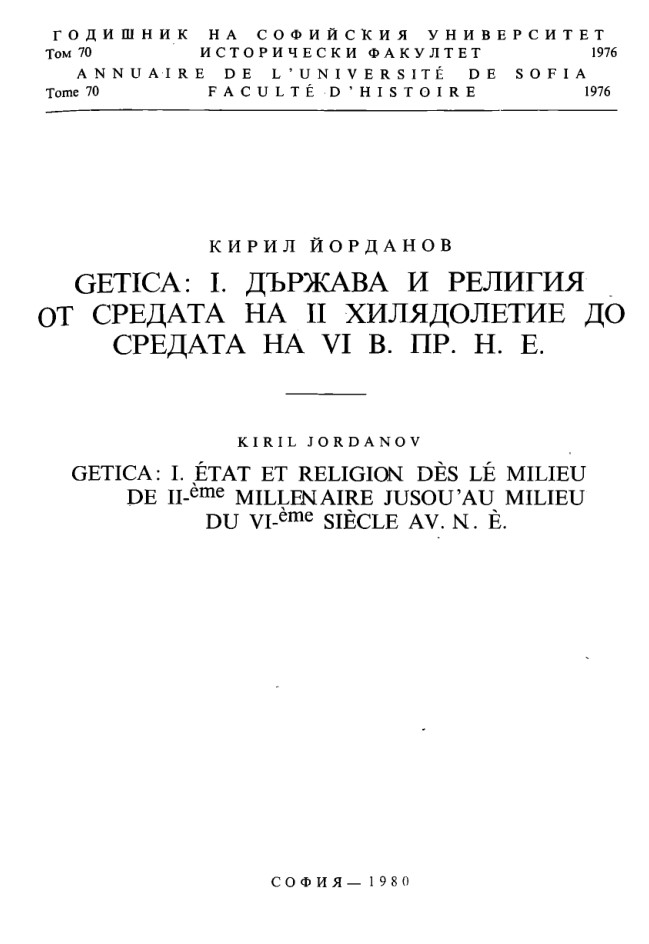Getica: I. State and Religion from the Middle of the Second Millennium to the Middle of the Sixth Century BC.
DOI:
https://doi.org/10.60053/GSU.IF.1.70.55-82Keywords:
Thrace, GetaeAbstract
Around the middle of the 2nd millennium BC, in the Late Bronze Age, the northeastern boundaries of the Thracian lands were part of the Mycenaean koine, as is evident from the numerous archaeological finds and the analysis of the scarce written records. With the development of productive forces and the increased intensity of production, clan ties loosened, gradually and naturally completing the process of the dying off of the clan community. The gradual transition from patrilineal to neighbour-territorial community, which probably continued throughout the third and first half of the second millennium BC, also came to an end. This was the time of the transition from the two-component antagonistic tribal to the neighbour-territorial commune, which enabled new forms of exploitation. The social structure thus established to create favourable conditions also for the development of state-building processes, which naturally in turn led to the refinement of religious notions and beliefs. It can be assumed that the common Thracian religious doctrine with its regional peculiarities was already finally formed by the middle of the 2nd millennium BC. The lower chronological boundary is characterised by a sharp increase in the written tradition of Thrace; Ionian µhistorical prose was born, and the ever-increasing archaeological material made it possible to locate the various centres of political life more precisely.
References
V. Раrvаn. Getica: О protoistorie а Daciei. Bucuresti, 1926, passim.
Постиженията на румънската историоrрафия са разгледани в статията на R. Vulре. Histoire des recherches thracologiques en Roumanie, Thraco-Dacica. Bucuresti, 1976, р. 1З-51; Ал. Фол. Тракия и Балканите през ранноелинистическата епоха. С., 1975, с. 35-59, с л-ра; И. Никулицз. Геты IV - III вв. до н. з. в Днестровско-Карпатских землях. Кишинев, 1977.
Postizheniyata na rumanskata istoriorrafia sa razgledani v statiyata na R. Vulre. Histoire des recherches thracologiques en Roumanie, Thraco-Dacica. Bucuresti, 1976, r. 1Z-51; Al. Fol. Trakia i Balkanite prez rannoelinisticheskata epoha. S., 1975, s. 35-59, s l-ra; I. Nikulitsz. Getы IV - III vv. do n. z. v Dnestrovsko-Karpatskih zemlyah. Kishinev, 1977.
Н. Dаiсоviсiu. Thrace et Daco-Getes а lа fin du Hallstatt et au debut de La Теnе en Roumanie. - Thracia, IV, Serdicae, 1977, р. 5-13.
D. Веrсiu. Contribution а l'etude de l'art Thraco-Gete, Bucuresti, 1974, passim.
Thraco-Dacica. Bucuresti, 1976, passim.
Аl. Fоl, A. Маrаzоv ~ Thrace and the Thracians, London, 1977, р. 144- 147.

Downloads
Published
How to Cite
Issue
Section
Categories
License
Copyright (c) 1980 Kiril Yordanov

This work is licensed under a Creative Commons Attribution 4.0 International License.
Annual of Sofia University "St. Kliment Ohridski" - Faculty of History (GSU-IF).







